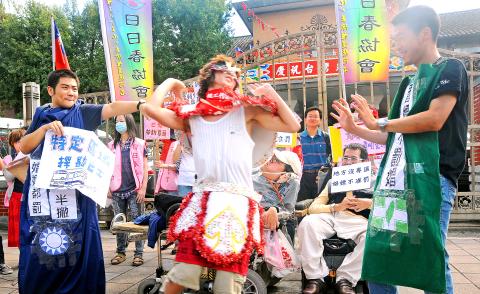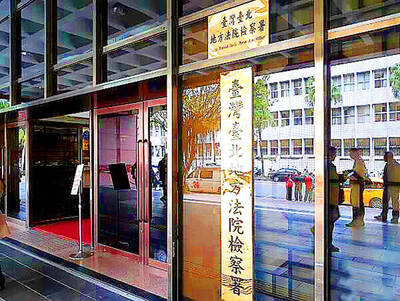As of today, commercial sex work within red-light districts designated by local governments is legal in Taiwan, as lawmakers yesterday voted to support the motion proposed the Executive Yuan.
With the Sunday deadline approaching — set by the Council of Grand Justices two years ago to address the unconstitutionality of Article 80 of the Social Order Maintenance Act (社會秩序維護法) that penalizes only prostitutes and not their clients — lawmakers voted for the amendment presented by the government and supported by the Chinese Nationalist Party (KMT) caucus.
On Nov. 6, 2009, the Council of Grand Justices in Constitutional Interpretation No. 666 found Article 80 in violation of the spirit of equality embodied in the Constitution and ruled that the article be invalidated within two years.

According to the amendment, people who engage in the sex trade outside red-light districts, both sex workers and customers, as well as those who sell or buy sex in public, face a fine of NT$30,000.
The amendment also allows procurers and brothel owners to operate in red-light districts, while they could be fined between NT$10,000 and NT$50,000 respectively, and be held in detention for three to five days, if they work outside the designated areas.
In opposition to the proposal, Democratic Progressive Party (DPP) Legislator Huang Sue-ying (黃淑英) put forward an amendment seeking to follow the Swedish model, which criminalizes customers, but not sex workers.
Her proposal was voted down 40 to two, with the two “yes” votes cast by herself and DPP Legislator Chai Trong-rong (蔡同榮).
The 32-member DPP caucus supported Huang in putting forward the amendment, but did not require its members to show up and vote against the 72-seat KMT caucus, which cast 41 ballots yesterday.
After the vote, Huang expressed “regrets” that the government and the KMT followed the “Dutch model, which has proved a big failure,” while rejecting the Swedish model that has seen the sex industry decline.
The passage of the amendment “provided legal protection for men to fulfill their sexual needs by giving them the right to go whoring” and “throws women back [to rely on] on their own resources [for protection],” Huang said.
It would also exacerbate the problem of human trafficking, Huang added.
Minister of the Interior Jiang Yi-huah (江宜樺), in charge of drafting the government-proposed amendment, opposed Huang’s proposal on the grounds that the Swedish model, in which clients are prosecuted and sex workers are not, could render the amended article unconstitutional.
Huang said that Jiang was wrong about the meaning of the equality principle in the Constitution.
“Equality means equality in essence and not equality in form. Women are at a more disadvantaged position than men, who are not prosecuted. Men have to pay for the social costs they cause,” she said.
She said the KMT government failed to see and pursue the values embodied in the Swedish model. According to this model, “women should not be viewed as sexual objects or have a price tag put on them.”
“Legalizing the sex trade would worsen human trafficking and discrimination against women, and the sex industry should not be regarded as a means to boost industry,” she added.
KMT Legislator Pan Wei-kang (潘維剛) said legalizing the sex trade in red-light districts “did not compromise our goal to gradually eliminate the sex industry.”
With a resolution attached to the act that required the government to actively provide sex workers with conversion training courses, the government would help sex workers to develop skills to earn their living without having to rely on sex work to survive, Pan said.
The new law comes into effect today, after President Ma Ying-jeou (馬英九) later yesterday promulgated the amendment to the act.
Jiang, meanwhile, urged local governments to “face the issue” and promised that the ministry would hold further talks with local governments on creating red-light districts.
However, civic groups both supporting and opposing the sex industry criticized the amendments to the Social Order Maintenance Act.
“The only purposes of the revision is to protect men’s right to hire prostitutes and to ensure that whoever wants to could have healthy women to buy,” Taiwan Women’s Link secretary-general Tsai Wan-fen (蔡宛芬) said yesterday. “We regret that women’s rights have gone back to where they were 30 years ago.”
The secretary-general of End Child Prostitution, Child Pornography and Trafficking of Children for Sexual Purposes Taiwan, Lee Li-fen (李麗芬), said that allowing the sex industry even within a specially designated area could be in violation of Article 6 of the Convention on the Elimination of all Forms of Discrimination against Women, which states: “Parties shall take all appropriate measures, including legislation, to suppress all forms of traffic in women and exploitation of prostitution of women.”
Collective of Sex Workers and Supporters secretary-general Chung Chun-chu (鍾君竺) also criticized the red-light district amendment as empty and regressive.
“The law says that local governments ‘could’ create special districts,” she told a rally outside the Legislative Yuan. “You [the government] tell us that both the sex worker and the client would not be penalized within the district, but where is it? So far, none of the local governments have any plans to create red-light districts.”

INVESTIGATION: The case is the latest instance of a DPP figure being implicated in an espionage network accused of allegedly leaking information to Chinese intelligence Democratic Progressive Party (DPP) member Ho Jen-chieh (何仁傑) was detained and held incommunicado yesterday on suspicion of spying for China during his tenure as assistant to then-minister of foreign affairs Joseph Wu (吳釗燮). The Taipei District Prosecutors’ Office said Ho was implicated during its investigation into alleged spying activities by former Presidential Office consultant Wu Shang-yu (吳尚雨). Prosecutors said there is reason to believe Ho breached the National Security Act (國家安全法) by leaking classified Ministry of Foreign Affairs information to Chinese intelligence. Following interrogation, prosecutors petitioned the Taipei District Court to detain Ho, citing concerns over potential collusion or tampering of evidence. The

Seventy percent of middle and elementary schools now conduct English classes entirely in English, the Ministry of Education said, as it encourages schools nationwide to adopt this practice Minister of Education (MOE) Cheng Ying-yao (鄭英耀) is scheduled to present a report on the government’s bilingual education policy to the Legislative Yuan’s Education and Culture Committee today. The report would outline strategies aimed at expanding access to education, reducing regional disparities and improving talent cultivation. Implementation of bilingual education policies has varied across local governments, occasionally drawing public criticism. For example, some schools have required teachers of non-English subjects to pass English proficiency

‘FORM OF PROTEST’: The German Institute Taipei said it was ‘shocked’ to see Nazi symbolism used in connection with political aims as it condemned the incident Sung Chien-liang (宋建樑), who led efforts to recall Democratic Progressive Party (DPP) Legislator Lee Kun-cheng (李坤城), was released on bail of NT$80,000 yesterday amid an outcry over a Nazi armband he wore to questioning the night before. Sung arrived at the New Taipei City District Prosecutors’ Office for questioning in a recall petition forgery case on Tuesday night wearing a red armband bearing a swastika, carrying a copy of Adolf Hitler’s Mein Kampf and giving a Nazi salute. Sung left the building at 1:15am without the armband and apparently covering the book with a coat. This is a serious international scandal and Chinese

NEGOTIATIONS: The US response to the countermeasures and plans Taiwan presented has been positive, including boosting procurement and investment, the president said Taiwan is included in the first group for trade negotiations with the US, President William Lai (賴清德) said yesterday, as he seeks to shield Taiwanese exporters from a 32 percent tariff. In Washington, US Trade Representative Jamieson Greer said in an interview on Fox News on Thursday that he would speak to his Taiwanese and Israeli counterparts yesterday about tariffs after holding a long discussion with the Vietnamese earlier. US President Donald Trump on Wednesday postponed punishing levies on multiple trade partners, including Taiwan, for three months after trillions of US dollars were wiped off global markets. He has maintained a 10 percent